
“Behold it is the Springtide of the year.
Over and past is Winter’s gloomy reign.
The happy time of singing birds is near,
And clad in bud and blooms are hill and plain.”
That is the first verse of my favorite Passover song. I sang it in Junior Choir at my Temple. I even sang a solo verse. I eagerly awaited the portion of the Seder when this song was sung. Passover is the only Jewish holiday which is entirely celebrated at home with a Seder which translates to “order”, as there is a specific order for the entire service, a few songs are sung throughout, but the general ones happen at the very end. Alas, this song, sung when I was young, no longer makes the cut. Call me and I’ll sing it for you.
As we know from the overblown movie epic “The Ten Commandments”, Passover celebrates the Exodus, when the Israelites, who had been slaves in the land of Egypt for generations, are finally allowed by the Pharaoh to flee, leaving most possessions behind, and escape, unharmed, across the Red Sea, only to wander for 40 years through the desert until they arrive in Judea, the Promised Land. Because Moses, their leader, lost his temper once, he is not allowed to enter. It is left up to Joshua to lead the 12 Tribes of Israel into the “Land of Milk and Honey”.
So we celebrate freedom each Spring with various special foods, rituals, songs and important questions. Because our people had to leave so quickly, they couldn’t wait for their bread to rise, so the bread they made was cracker-like. It is called matzah. There are other symbols on the Pesach plate too, each with a special meaning, some reminding us of the tears shed by our slave ancestors, some of the mortar for the bricks they used to build the monuments to the pharaohs. Some are symbols of Spring and renewal, some symbols of the ten plagues, increasingly destructive, brought down by God to prove He is mightier than the Egyptian gods and Pharaoh must let the Israelites go free.
During the Seder I attended (more on that later), we were reminded, as the Israelites crossed the sea safely, then saw the sea swallow their oppressors, they rejoiced. But the Almighty admonished them. The Lord reminded them that ALL people are children of the Lord. God takes no delight in anyone’s destruction and caused the Children of Israel to stop celebrating the death of their enemy. A powerful lesson for today.
The word “Pesach” means to pass over. It also refers to the Paschal lamb that was sacrificed for the last plague, the blood used to mark the doors of the Israelites’ homes, as the final plague was death of the first-born son. The Angel of Death “passed over” the homes that had the marking on the sides of the doors, but no one else was spared, including the son of the Pharaoh himself. He relented and let all the Israelites go free.
Thousands of years later, as Christianity was taking root, the lamb came to symbolize the sacrifice of Jesus and “lamb of God” has a place in the Christian liturgy. More sinister, that lamb’s blood on the door posts of the house took on a different meaning. Particularly during the Middle Ages, but at various other times as well, ignorance and superstition took hold, dark tales were told, beliefs circulated of the need for the blood of a Christian child for Jewish ritual; for the making of matzah, or for the four cups of wine, drunk on Passover. Ignorance, superstition, conspiracy theories, fear of “the other”; all come from ignorance, lack of tolerance, knowledge, belief in science, love and acceptance of fellow human beings (as is taught in most moral religious theory). This was true then as it is now. Ignorance, superstition and fear are powerful forces for evil.
The first incidence of this took place in Norwich, England as a crowd rose up, killing Jews. This is called “blood libel” and caused Christians to hate Jews, even to kill many at this time of year. It was only within the past few decades that the Pope formally denounced the notion of blood libel and officially “forgave” the Jews for the death of Jesus. Easter (also a spring festival with bunnies and chickens), harkens back to pagan springtime rites as well.
We probably all know that Jesus’ Last Supper was a Passover Seder. My father loved to tell jokes and was a gentle man. The following was one of his favorites and he told it every year as we gathered, waiting for the Seder to begin: “Just think, 2,000 years ago tonight Jesus said, “OK, everyone who wants to be in the picture, sit on this side of the table.”
Passover was always a fun time in my household. For many years, we celebrated at my Aunt Pauline’s house with many aunts, uncles and cousins spread out across two rooms of her small home. I’m not sure how she served so much food or how we got through the entire Haggadah, but we did, with children running everywhere. Mayhem, but such fun!
At a certain point, we moved over and celebrated one block from my house at my parents’ best friends, Ray and Mildred Berry. The following photos are from 1973, during my junior year at Brandeis (which would shut down for the holiday, as there are certain foods that are off-limits, so easier to shutter the cafeterias and send everyone home) and while my brother studied at Hebrew Union College for the rabbinate. I found these in one of my mother’s albums.
They had three children of their own, some close in age to us, Ray’s mother would often attend. She was a former opera singer and Ray played piano, so music was a big part of the Seder. They had other friends and family to the Seder, mostly adults. Less mayhem, good food and good music, lots of singing around the piano at the end of the evening. I thoroughly enjoyed those evenings during my later years at home. The Berrys always felt like family. Ray died young (he and Dad constructed the stand for my chuppah, borrowed from an artist friend for my wedding), Mildred remarried, but stayed in close touch. We exchanged letters until her death.
When I married, I learned Dan’s family didn’t know much about being Jewish. To them, Passover was a home cooked meal of Jewish food with a few blessings mumbled by their grandmother. I was very fond of and close to their mother and grandmother, but was nearly in tears during my first Passover of married life. It was nothing like my happy experiences with my own family with a formal Seder.
As we made friends in our married life, we were invited to other families who had nice Seders and that was great. Once David was born, I had my own little Seder, just for our small group, but it worked.
The food is an acquired taste, but Jill, our nanny from Barbados, was a good sport about the gefilte fish, though she didn’t ask for seconds. As my family grew larger, I decided to grow my gatherings as well and invited neighbors with about the same tolerance for length of service as ours. Even an abbreviated Seder (and I tried several different Haggadahs before I found one that I liked) lasts about 45 minutes, going through each step. I started bringing in the food, but finally had it catered, as my group grew to number 15 in all and I led the service too. Those were fun times, before the kids went to college.
I set a nice table and invited all comers, Jewish and non. We all had a good time, ate well and enjoyed each other’s company. Now we go to other’s homes, though this year, with social distancing, I thought we’d be alone. Since Dan doesn’t care for Jewish ritual, we would skip it altogether.
My darling and learned brother sent an invitation to join him and his wife for Seder via Zoom to me and various cousins and close friends in cities around the country. His children are in Brooklyn and Chicago. She even sent, in pdf format, a copy of the Haggadah they used. By some miracle, I had one of my own, though discovered that what he sent had been edited to his liking and he ran it full-screen, during the service, though I followed along on my iPad. We each had our own ritual food and symbols by our sides in front of the computers (my brother is a rabbi, and long-time professor at Hebrew Union College, the seminary that trains Reform rabbis), and each participated at our own home as he led the Seder. He has been teaching remotely for weeks now, so is good with Zoom. Annie set up break-out groups during dinner. The younger cousins got together. David even called in from London for a bit to say hi. Technology; got to love it!
Hours before my Seder, David sent me a photo of what he and Anna did (they are 5 hours ahead). She is a vegetarian, so made some appropriate substitutions on their Seder plate.
Annie and I began texting about a half hour before the service was due to commence. She normally has 30 people for Seder, extending her dining table all the way into the living room, using paper goods and plastic utensils. She commented how strange it felt to only have two place settings, put pulled out the good china and silver and lit her Arenstein grandmother’s candle sticks. We wash our hands multiple times throughout the service (as if anticipating these conditions). She said hand sanitizer would suffice. Here’s what their table looked like.
While we conversed, I took a photo of my setup. I don’t have a laptop computer, only a desk top, so it won’t travel to my kitchen table and I wanted to use my iPad for the pdf of the Haggadah (besides, my iPad is a mini), so I cleared all the space on either side of the computer and set up an old TV table (yes, the last of my mother’s), so I could have as much space around me as possible, as there are a lot of elements involved with the Seder. Here’s a shot of one corner of my Seder “table” (some items were on the other side of the computer). Just as Annie used her grandmother’s candlesticks, I have my grandmother, Belle Stein’s candlesticks, brought with her when she emigrated from Russian in 1906. So they are now over a century old. I love and cherish them. I am her youngest grandchild and it means so much to me that I inherited them. L’dor v’dor…from generation to generation. My matzah cover is a dyed handkerchief, made by one of the kids at our Temple nursery school, can’t even remember which child or how many years ago. It was lovely to pull it out again. My Kiddush cup was a gift from my father on my wedding day. We used it in our ceremony. The Seder plate was my parents. They bought it when they visited Rick in Israel in 1971. It has an Eilat stone in the center. Everything is full of memory and meaning. The daffodils were cut from my front yard that morning for a touch of spring on my table.
I think everyone around the world tried a Zoom Seder on Wednesday night. We had technical difficulties and started late, but finally got in gear. As we waited for everyone to come on, I took a shot of our virtual community, though my nephews hadn’t joined us yet. Once we started, Rick had the Zoom tiles running down the side of the screen (not all were visible at any one time), with the text of the Haggadah running down the center of the screen, for all to follow along. He muted all except his screen so he and Annie could lead, comment and sing. At certain points, he asked for participation and each of us to unmute, individually, but due to virtual time lags, we couldn’t all unmute at once, so couldn’t sing together. We were only unmuted during dinner, though we came and went, depending where we were eating. I walked around the corner to my kitchen, as I couldn’t really eat soup in front of my computer, but it all worked quite well, considering. We had our food and Passover symbols in front of us to use during the service, so could each participate at the appointed time.
My brother chose to use the Haggadah edited by Herbert Bronstein, published by the Central Conference of American Rabbis, New York, as seen in the Featured photo. After the holiday candles are lit and the first of four cups of wine are drunk, we are reminded this is a time of birth and renewal and a poem is chanted from the Song of Songs which includes the verse, “I am my beloved’s and my beloved is mine” (roughly transliterated: ani la dodi, v’ dodi li; excuse my lack of Hebrew phonetics.) As my brother, who, like me, has sung all his life, I was overwhelmed.
Rick was ordained two weeks before my marriage. His first official act as a rabbi was, along with my long-time Temple rabbi, to co-officiate at my wedding, and he sang that song. Here we were, almost 46 years later, under these difficult circumstances, hearing my brother’s gorgeous baritone, chanting the same verse he sang to me and Dan on our wedding day. It took me up short, gave me comfort and joy, caused me to reflect, gave me hope.
For all the symbols of the Seder, they lead to the 10 plagues, brought down on Pharaoh so that the Israelites will finally be set free and allowed to leave Egypt. Each plague is bad, and Pharaoh claims he will agree, only to change his mind when each plague subsides, until finally, death is brought upon the land. His own household is not spared; his oldest son and heir is killed and he finally relents.
At this point in the service, we read the one word Hebrew name for each plague, stick our pinkie finger in our cup of wine and drop the red droplet on our plate, reminding us of the blood that is about to be shed. But before we read off the plagues, Rick interjected this thought: “For our people, it was a watch night; they were told to stay indoors for their own well-being while a plague rages outside”. The parallel was missed on no one in our virtual community. The text that followed, written in 1982, I found so powerful that I reproduce it here.
“Each drop of wine we pour is hope and prayer
that people will cast out the plagues that threaten everyone
everywhere they are found, beginning in our own hearts:
The making of war,
the teaching of hate and violence,
despoliation of the earth,
perversion of justice and of government,
fomenting of vice and crime,
neglect of human needs,
oppression of nations and peoples,
corruption of culture,
subjugation of science, learning, and human discourse,
the erosion of freedoms.”
My brother put particular emphasis on “perversion of justice and government”, and punched the words ‘science’ and ‘learning’ as he read these lines. I remind you that this Haggadah we used was first published in 1974, last revised in 1982. I turned the corner of the page in my own copy and wrote my brother’s introductory commentary in the margin. I wanted to be able to share it with this community. How thoroughly we can relate to the message today. But as we know from the psalms: light cometh in the morning. We must stay safe, ride out this horrible time and the abomination in the White House. We truly are stronger together, even if we are only together virtually at the moment.
Chag Sameach (Happy Holiday). By tradition, we end the Seder by saying, “Next year in Jerusalem”, but this year, I think we say, “Stay safe, be well, next year: back to normal, Vote Blue!”
Retired from software sales long ago, two grown children. Theater major in college. Singer still, arts lover, involved in art museums locally (Greater Boston area). Originally from Detroit area.


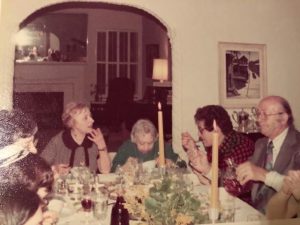
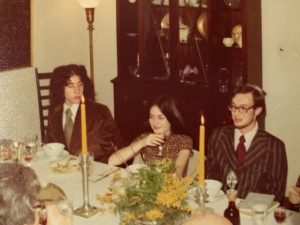
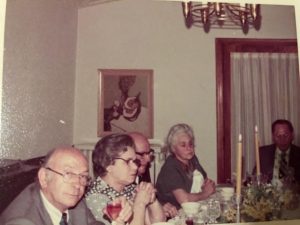
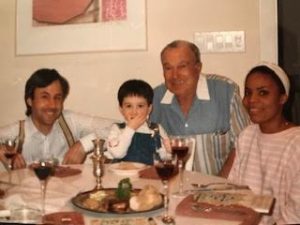
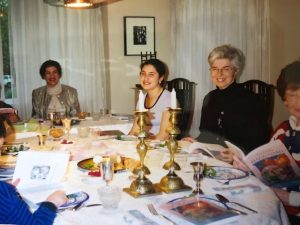
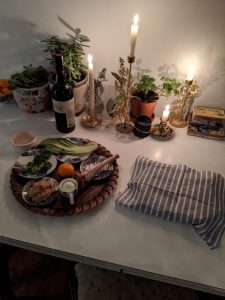
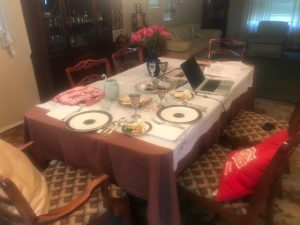
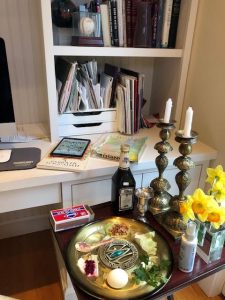
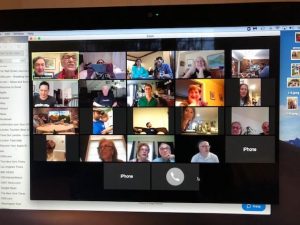

Dear Betsy, This week I took what was perhaps a cowardly way out and posted two humorous Passover memories.
But your memories and some of the others posted today brought somber thoughts, and most importantly, inspiration. Next year may we celebrate once again with friends and family in a nation rededicated to humane and ethical values. Dayenu.
Dayenu. Blessings to you and Danny.
What a wonderful story, Betsy.
First of all, your historical/religious description of Passover was wonderfully helpful to a pagan such as me in better understanding the holiday and the significance of many of its features. It really pulled so many things together nicely.
Then I loved the descriptions of your various Passover celebrations over the years. And, as always (why should I be surprised?) accompanied by your great photos that really bring the events to life.
And then your description of your Zoom Seder this past week. It sounds amazing and thank you for sharing both the text and your brother’s comments. Truly both timely and timeless.
Finally, of course, I loved your concluded comments. And may we all Vote Blue and not wander in the desert for forty years.
Amen!
Thank you, John, for all your comments above. I wrote with a general, not a knowledgeable, audience in mind, hoping to do some education along the way, as I send this story to many friends, not all of whom are Jewish. As most know by now, I also tend to write several weeks ahead, so my story was finished when I was invited to join my brother and sister-in-law’s Seder, did a quick edit last Monday to reflect that. However, I found the event SO incredible (as I described) that I spent all Thursday morning revising the end of my story to reflect that. I didn’t eat, dress or exercise before I’d written all I wanted to say. I just had to get my thoughts out. I was overwhelmed, being with my brother for the first time, well probably since that 1973 Seder pictured. It also gave me a chance to do a deep dive into my mother’s albums. I came across some wonderful old photos of cousins I’d been “with” virtually the night before and sent those to them (photos from the mid-60s). They really liked those as well. It gave me a chance to connect with family in all sorts of ways that I just loved. Very powerful for me.
Betsy, this is a wonderful story! I skimmed over the religious/historical part because I already knew it, but saw enough to realize you had done an incredible job for those who didn’t (as you mention in your comment to John). I loved reading about all your different seders over the years! But I was the most moved by your description of the Zoom seder you just had. From the picture of the Zoom screen showing 20 different households participating, to the description and picture of you with the full setup on a TV table so you could look at your desktop computer (the daffodils are a nice touch), to the very moving words added by your brother, the whole thing just warmed my heart, and might have even brought a tear to my eye. I want to write down what he said and add it to my Haggadah too! Thank you so much and chag sameach!
Thank you, Suzy. I sent a long note to Rick and Annie the next morning (before getting on to Retro to update this story). I just heard back from my incredible sister-in-law this morning. In addition to COVID-19, another plague visited them, about a half hour after we finished the seder on Wednesday night, a huge storm swirled up and they took to their basement. They lost power for 48 hours, had to cancel their second Zoom seder (they still had one for the two of them by candle light), and just got their power back last night, in time to do a singalong with their Chicago son and some friends. So they added Darkness to their list of real plagues.
My brother is really something. Very learned, well-respected in his field. A friend from the old neighborhood, whose father was our Temple rabbi (and married Dan and me), messaged me that, when he pulled out his Haggadah, he found essays at the back written by my brother. He thought they were brilliant. He writes all the time, I don’t even know what’s out there. Google him and see: Richard S. Sarason.
Chag Sameach to you too, Suzy.
That’s one big Zoom Seder, Betsy, and your entire story brought back so many memories of various Seders from way back to the present. Echoing Suzy’s comment, I love what your brother said. And, the Haggadah picture cracked me up because Dick found this exact same one, and I downloaded another one from a link to a Reform temple that his daughter sent me. Our Seder is this evening (Saturday), so now I am extra inspired.
Happy to know you will be celebrating, Marian, and that I brought back happy memories for you. This was not the original Haggadah that I featured. As others have commented, I, too, have several sets and settled on a different one to use when I ran the larger seder for family and friends. But this was the one my brother used, so I changed up photos, as this is the one quoted from at the end of my story.
Be safe, my friend. Chag Sameach.
Betsy, what a wonderful story! I wish I could hear you sing the first verse of your favorite Passover song! I found myself wishing you would add an audio file to your story…all it takes is using your cell phone voice recorder, then uploading and saving the recording as a Media file in your story, and then inserting it.
I love your father’s joke about The Last Supper…I’m sure it will come to my mind the next time I see that photo…er, I mean painting. The description of your brother’s singing and words at your Zoom Seder really moved me. My family celebrates Easter (and later today — it’s Sunday as I write this — we will all be Zooming), although I have been a guest at the Seders of close friends. I have to admit that at the first one, when I was a very young girl, the tongue didn’t agree with me, and doesn’t to this day. But I truly appreciate all the history you included in your story because although I love the rituals, I never really understood them.
Your table setup was just beautiful…the candlesticks, the fresh-cut daffodils. I love the humility of memory and meaning.
Your closing paragraphs really resonated. I will admit that I have wished bad (even Covid-19) would come to this president (whose name I refuse to speak) because I hold him responsible for the early spread of this plague in the U.S. Your story reminds me that I should at the very least keep that thought to myself. But Vote Blue, indeed!
Thanks for the info about how to make an audible file, Babs. Very useful, but right now I’m a bit hoarse with seasonal allergies, so I’ll pass for the moment. Glad I filled you in on what all the rituals mean. I know I was long-winded, but (as I mentioned to John), I send this story out to lots of friends beyond the Retro writers; some are not Jewish, so I wrote with those in mind.
My father’s joke always brings a smile to my face. I can still picture him telling it, sitting on his sister’s couch, with people swirling around him, a vivid image of him so many years ago now, probably 50.
As for your feelings about Jewish food, I’ve NEVER had tongue at a Seder…that was deli meat only (not nice enough for a Seder meal) and I’ve never liked it either, so we are kindred spirits on that score. We usually had brisket or some form of chicken at any Seder I’ve attended.
Clearly, we have the same political beliefs, Babs. So let’s get through this and do all we can to turn out Blue voters (including Bernie voters) in HUGE numbers in the fall. I do believe our lives depend on it!
The president has blood on his hands.
Betsy, what a beautiful explanation of the meaning of Passover. I love that you included images from your Zoom seder as well. I love your brother’s closing words — back to normal and vote blue. That’s the only way we will ever get back to a semblance of normal, which we took fo granted when we had it. Hope you and your loved ones stay safe and enjoy the best-as-possible Passover. By the way, I have used the same Haggadah as the one featured in your image.
The closing words were mine, but they could have come from Cincinnati, for they do all they can (in a swing state!) to get voters to vote blue. Annie shared a YouTube video going around from Harvey Fierstein about the “next year in Jerusalem” part; pretty funny, but essentially saying “next year in our HOMES, together”, which is what I think we all feel. During dinner they talked a lot about how much they enjoyed listened to their (Republican, but competent) governor’s daily briefing (we NEVER listen to the Orange One’s…never)!
I think the Haggadah is fairly standard for the Reform movement. It was the very first one that I purchased, some 32 years ago. Rick made some alterations to it, but it does quite well. Thank you for your kind words about my rather long-winded description of the meaning of Passover. It felt urgent this year.
I felt swept up in learning about the traditions of Passover and the meanings and sentiments of so many deeply steeped traditions. I’ve always felt a bit envious of Jewish ritual, in birth, death, marriage and rites of passage. An external structure to hold our hopes and dreams. As you wrote about this year’s Seder I was moved to tears, thinking about your brother’s voice speaking what all ears need to hear! Thank you for the excellent writing and touching story, Betsy!🙏🏼🥰🦋
Thank you for this lovely comment, January. It meant a lot to me. Your stories/poetry are always so full of emotion for me! I am so happy that I could share some of my heritage with you.
What lovely thoughts January!
Stay safe!
Thanks for this wondrous tour of your family Seders over the years. As usual, I love the explanations of why each element is meaningful to you. Also as usual, I love the photos—Mildred Berry was my kindergarten teacher! And I love your father’s sense of humor, and still recall him well. Happy Passover.
Thank you, John. How amazing! I knew that Mildred was a puppeteer (I was her helper at times), but not a kindergarten teacher! Great connection. And thanks for the shout-out to my father; a kind, gentle soul indeed. I well-remember how much he enjoyed entertaining you and Patti in January, 1986 when you came to visit me and infant David down in Laguna Hills. He cooked his favorite fish and found lodging elsewhere so you two could spend the night with me. He was a warm, loving man, greatly missed. I was sorry that we didn’t get to come visit last week, as intended, but I did enjoy this Passover much more than I have in years! Sending love your way.
I should clarify that Mildred was my kindergarten teacher in Sunday School, not regular school. Or maybe it was pre-kindergarten! But I loved her as a teacher, and I do seem to remember puppets. Thanks for the warm memory of your father; we remember that weekend well.
That sounds familiar and makes sense, John. I have an old, faded photo of Mildred with me as her puppet assistant, and of course, she entertained at all my birthday parties.
The weekend with my father was a very nice memory, except for being thrown out of the pool area because some old biddy complained that we had violated their rules! Another example of extreme behavior, since David was 5 months old, couldn’t even crawl, so couldn’t run around and cause any bother, or swim in their precious pool, but “no children allowed” had to be followed to the letter of the law!